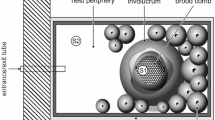Summary
The nesting behavior of the euglossine beeEulaema nigrita was observed in the laboratory after being transferred from three nests to observation boxes. Nests were re-used by successive generations with more than one female working in each re-use process. Associated females were always of the same generation. All females that shared a nest foraged for construction materials (mud, excrement and resin) and each constructed, provisioned and oviposited in her own cells. The number of cells constructed by each female ranged from one to 23. Females stayed in the nests for periods ranging from 15 to 59 days during the hot and wet season and from five to 78 days during the cool and dry season. The egg-to-adult period was related to climatic conditions, and in all re-use processes it was longer than the time of residence of the females in the nests. The meloid beetleMeloetyphlus attacephalus was the only nest parasite. Due to the attack method employed by this parasite, the presence of more than one female in the nest did not result in improved nest defense.
Similar content being viewed by others
References
Abrams, J. and G. C. Eickwort, 1981. Nest switching and guarding by the communal sweat beeAgapostemon virescens (Hymenoptera, Halictidae).Ins. Soc. 28:105–116.
Bennett, F. D., 1965. Notes on a nest ofEulaema terminata Smith (Hymenoptera, Apoidea) with a suggestion of the occurrence of a primitive social system.Ins. Soc. 12:81–92.
Danforth, B. N., 1989. Nesting behavior of four species ofPerdita (Hymenoptera: Andrenidae).J. Kansas Entomol. Soc. 62:59–79.
Dodson, C. H., 1966. Ethology of some bees of the tribe Euglossini (Hymenoptera: Apidae).J. Kansas Entomol. Soc. 39:607–629.
Eberhard, W. G., 1988. Group nesting in two species ofEuglossa bees (Hymenoptera: Apidae).J. Kansas Entomol. Soc. 61:406–411.
Erickson, E. H., W. R. Enns and F. G. Werner, 1976. Bionomics of the bee-associated Meloidae (Coleoptera); bee and plant hosts of some nearctic meloid beetle — a synopsis.Ann. Entomol. Soc. Am. 69:959–970.
Garófalo, C. A., 1985. Social structure ofEuglossa cordata nests (Hymenoptera: Apidae: Euglossini).Entomol. Gener. 11:77–83.
Garófalo, C. A., 1987. Aspectos bionômicos e sociológicos deEuglossa (Euglossa) cordata (Hymenoptera: Apidae: Euglossini). F. F. C. L. Ribeirão Preto-USP. Tese de Livre-Docência. 171 pp.
Garófalo, C. A., 1992. Comportamento de nidificação e estrutura de ninhos deEuglossa cordata (Hymenoptera, Apidae, Euglossini).Rev. Brasil. Biol. 52:187–198.
Garófalo, C. A., E. Camillo, M. J. O. Campos and J. C. Serrano, 1992a. Nest reuse and communal nesting inMicrothurge corumbae (Hymenoptera, Megachilidae), with special reference to nest defense.Ins. Soc. 39:301–311.
Garófalo, C. A., E. Camillo, J. C. Serrano and J. M. M. Rebêlo, 1992b. Utilization of trap nests by Euglossini species (Hymenoptera: Apidae).Rev. Brasil. Biol. (in press).
Lin, N., 1964. Increased parasitic pressure as a major factor in the evolution of social behavior in halictidae bees.Ins. Soc. 11:187–192.
Lin, N. and C. D. Michener, 1972. Evolution of sociality in insects.Q. Rev. Biol. 47:131–159.
McCorquodale, D. B., 1988. Relatedness among nestmates in a primitively social wasp,Cerceris antipodes (Hymenoptera: Sphecidae).Behav. Ecol. Sociobiol. 23:401–406.
McCorquodale, D. B., 1989. Nest defense in single- and multifemale nests ofCerceris antipodes (Hymenoptera, Sphecidae).J. Ins. Behav. 2:267–276.
Michener, C. D., 1964. Reproductive efficiency in relation to colony size in hymenopterous societies.Ins. Soc. 11:317–342.
Michener, C. D., 1974.The Social Behavior of the Bees: A Comparative Study. Harvard University Press, Cambridge, Mass. 404 pp.
Pereira-Martins, S. R., 1991. Biologia deEulaema nigrita. 2. Atividades nidais.Pap. Avuls. Zool. 37:237–243.
Pereira-Martins, S. R. and W. E. Kerr, 1991. Biologia deEulaema nigrita. 1. Construção de células, oviposição e desenvolvimento.Pap. Avuls. Zool. 37:227–235.
Roubik, D. W., 1989.Ecology and Natural History of Tropical Bees. Cambridge University Press, New York, 514 pp.
Roubik, D. W., 1990. A mixed colony ofEulaema (Hymenoptera: Apidae), natural enemies, and limits to sociality.J. Kansas Entomol. Soc. 63:150–157.
Young, A. M., 1985. Notes on the nest structure and emergence ofEuglossa turbinifex Dressler (Hymenoptera: Apidae: Bombinae: Euglossini) in Costa Rica.J. Kansas Entomol. Soc. 58:538–543.
Zucchi, R., S. F. Sakagami and J. M. F. Camargo, 1969. Biological observations on a neotropical parasocial bee,Eulaema nigrita, with a review on the biology of Euglossinae (Hymenoptera: Apidae). A comparative study.J. Fac. Sci., Hokkaido Univ., Zool. 17:271–380.
Author information
Authors and Affiliations
Rights and permissions
About this article
Cite this article
Santos, M.L., Garófalo, C.A. Nesting biology and nest re-use ofEulaema nigrita (Hymenoptera: Apidae, Euglossini). Ins. Soc 41, 99–110 (1994). https://doi.org/10.1007/BF01240577
Received:
Revised:
Accepted:
Issue Date:
DOI: https://doi.org/10.1007/BF01240577




